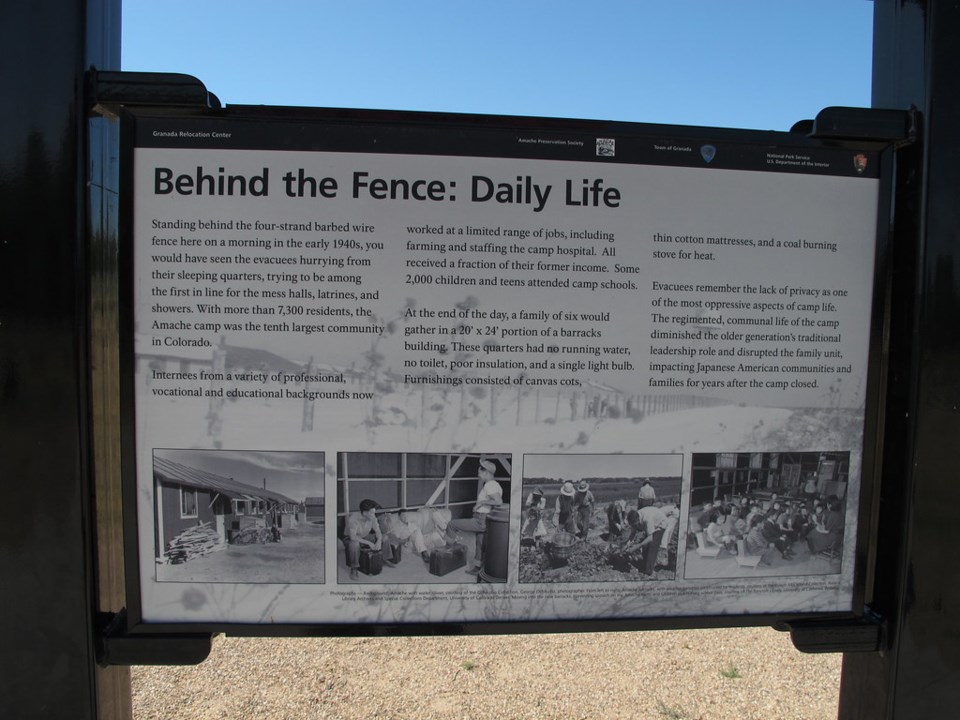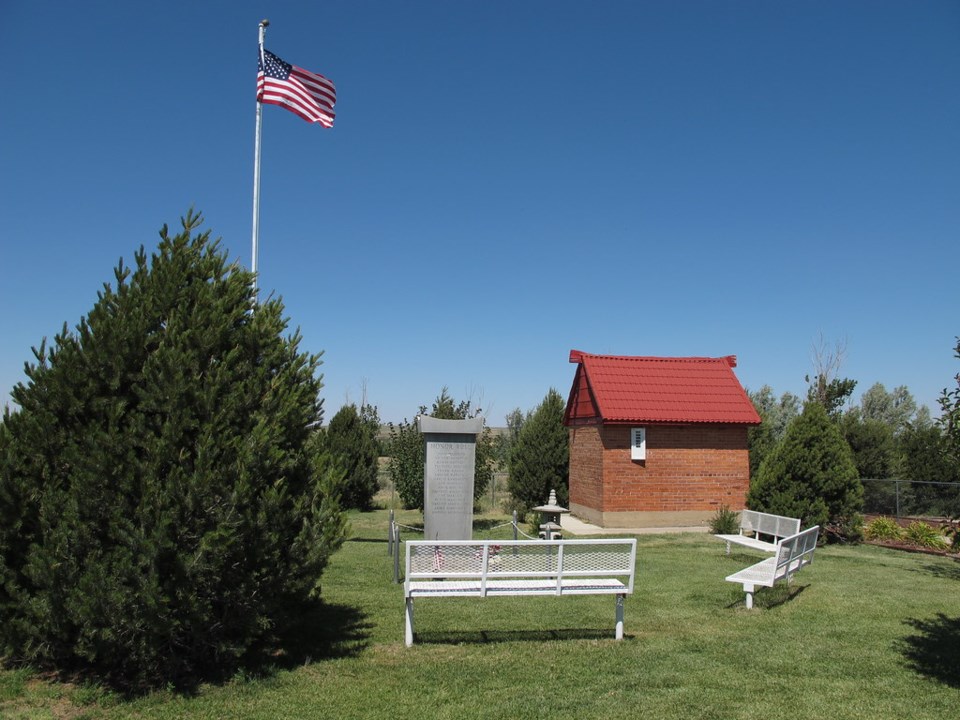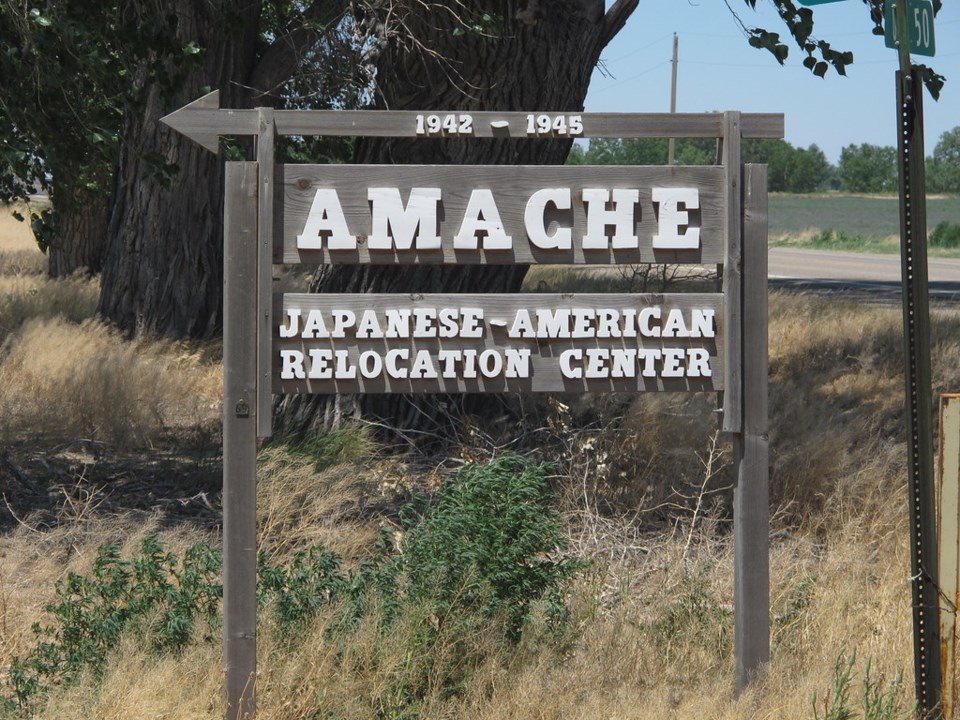Editor’s note: This story was originally published by The Colorado Sun and was shared via AP StoryShare.
***
At first, the trip unfolded as just an academic tracing of family history.
John Tonai had for years heard the stories from his father, Minoru, about the Amache internment camp in southeastern Colorado, where the U.S. government transported thousands of Japanese Americans from California and held them behind barbed wire and guard posts for three years during World War II. The family lore became a constant soundtrack that, over time, receded to a kind of background noise — always heard, seldom absorbed.
But in 1990, as a master’s student at the University of Northern Colorado, Tonai actually visited the site just outside the town of Granada. He explored the remnants of building foundations and other landmarks for an independent study project in photography.
His father had described the exact location of the family barracks — Building 9L, Apartment B. Tonai approached a slight dip in what remained of the foundation, a subtle reminder of the doorway to another time.
Just stepping across that threshold proved a life-changing experience.
“When I did that,” recalls Tonai, 60, “the stories came flooding back. My father used to talk about things like walking down a certain road at the camp, and now I could envision him as a 13- to 16-year-old boy, actually doing it.”
Since Tonai’s experience decades ago, the Amache site has been curated and improved, largely under the leadership of the Amache Preservation Society, a local school project headed by John Hopper, a social studies teacher-turned-principal of Granada High School. Hundreds of local students have found the single square mile of land a valuable historical resource, but it also has hosted years of pilgrimages for the former incarcerees and their families and drawn more than 20,000 visitors annually.
All of that has led Amache to another threshold. Supporters of the site have pushed to establish it as a unit of the National Park System, a designation that could literally put Amache on the map as a federally run tourist destination. It also would shift most of the work around caring for it — a tall task that up to now has been mostly the province of Hopper and a handful of high school kids — to federal authorities.
People like Tonai and his father, about to turn 92, have lent their voices to the ongoing preservation of a site that has broad historical and cultural importance, but particular resonance for the families of those who experienced Amache firsthand.
“He probably has stronger thoughts than almost anybody I know,” Tonai, who now works as an exhibit preparator and photographer for the Japanese American National Museum in Los Angeles, says of his father. “My dad was a teenager, just coming into his own, and he was always very angry about it. He has always supported preserving the memory of the camp.”
 "Amache (Granada) Japanese Internment Camp" By rocbolt / licensed under CC BY-NC 2.0
"Amache (Granada) Japanese Internment Camp" By rocbolt / licensed under CC BY-NC 2.0 “Right now, it’s kind of in limbo,” Hopper says. “The way I’m looking at it, we’ve lost a year with the COVID deal, not being able to meet in person.”
An already lengthy federal process — the study and recommendation alone have a three-year timeline — suddenly seemed to get nudged even further into the future. For Hopper, who has seen his work with Amache become an all-consuming passion, the prospect of handing the lion’s share of the responsibility for the site to the government experts sooner rather than later offers peace of mind — not to mention the chance for actual retirement.
“It’s something that not only has become a part of my life, but it’s on my mind just about every day — doesn’t matter what day,” Hopper, 57, says of Amache. “It’s always on my mind. It’s made me what I am, from an educational standpoint with these students. I want to make sure that the school continues to be involved as well.”
At a time when rural Colorado struggles with declining population and attendant economic challenges, Amache offers restorative opportunities. The work of the Amache Preservation Society has already helped restore a valuable historic and cultural marker. And in combination with both the Sand Creek Massacre National Historic Site near Eads and a similar attraction at Bent’s Old Fort in La Junta — each less than an hour’s drive from Granada – it creates a historic triangle on the Eastern Plains.
National Park designation would only add to the attraction, Hopper figures.
A mural on the front of the Amache Museum bears the likeness of Kiyoshi Muranaga , a Japanese American imprisoned at the camp who later volunteered to join the U.S. Army. Killed in action in 1944, Muranaga was posthumously awarded the Congressional Medal of Honor in 2000. (Mike Sweeney, Special to The Colorado Sun)
“People would be a lot more aware,” he says. “Once they’re down here and tour all these sites, there are a lot of others. We’ve got the Santa Fe Trail, plus museums in Holly and Las Animas. We’re building up a decent historical area for people to come and see.”
At Amache, structures from barracks to the camp’s guard and water towers have been reconstituted on the grounds. Memorials have been constructed or restored. An original recreation center at the camp that had been moved to Granada’s city park was returned to its original foundation. A museum in town has slowly collected an impressive array of artifacts from the era.
“People come from a long distance away to see Amache,” Hopper says. “That’s a help for the community, as well as people spending dollars and time in Granada. That’s the other thing: You become a National Park site, and it helps the community with more jobs and kind of solidifies that the community will stay.”
COVID-19-related delays in the federal study’s public engagement effort, which stalled last spring, could push that portion of the process to next spring, notes Jeremy Sweat, chief of planning and compliance for the National Park Service regional office in Lakewood. Some meetings scheduled to take place in person, including some on the West Coast to accommodate original internees and their families, had to be canceled.
Once a new NPS team has been assembled, he adds, some virtual meetings will be added to the schedule to receive public input. When that portion of the process is complete, the federal staffers will start analyzing the four key criteria that figure into the study recommendation to the Secretary of the Interior, who then forwards the report to Congress.
Congress isn’t bound by the findings, which are designed simply to inform lawmakers. Any member could still introduce a bill to establish Amache as a unit of the National Park System, Sweat says.
Checking the boxes
The Amache incarceration site already has been designated a National Historic Landmark. But to become a unit of the National Park System, it would need to pass four additional tests during the site study. On average, about one in four studies results in a recommendation for inclusion.
Even with approval, the NPS notes, it can take as long as 10 years to get a new national park up and running.
For now, Amache is hoping to clear four hurdles of the site study:
Significance: Amache’s status as a National Historic Landmark already pretty well checks this box.
“We typically still do some level of analysis to make sure nothing has changed, that there’s no new information,” Sweat says. “But in this case, it’s safe to say it’s nationally significant.”
A couple of other factors also weigh in its favor.
Gov. Ralph Carr’s welcoming the arrival of Japanese Americans, in stark contrast to many other reactions across the country and even sentiment within Colorado, bolsters the site with a unique set of historical circumstances. Additionally, Amache experienced much less conflict and violence than other incarceration sites.
Suitability: This is where the process becomes even more detailed, as the focus turns to the site’s uniqueness and whether or not it’s represented or protected by other entities. Here, the study completes a comparative analysis to other sites — and among the 10 camps that were scattered across the interior U.S., a handful of others have already achieved federal recognition.
Sweat explains that the study looks at whether other sites tell the exact same story or have similar resources. But he emphasizes that the fact that there are other incarceration sites in other areas of the country in no way disqualifies Amache from consideration. The U.S. has many federally recognized sites that reference the same general historical narrative, such as the Civil War or Revolutionary War or even other Japanese American sites.
“As long as it’s demonstrated that the site has a unique history and resources, that doesn’t count against it,” he says.
Feasibility: This portion of the study looks at whether the site is of sufficient size and appropriate configuration to allow the NPS to manage it at a reasonable cost. Sweat says that access is a key factor here — whether the site can be accessed safely by visitors, but also that it can be acquired as federal land.
The Amache grounds are owned by the town of Granada, which Hopper says currently seems disposed to offer the land for a National Park site. But that can change with the political winds, which is another reason Hopper would like to see this process move quickly.
“With local elections, you never know,” he says. “Maybe down the road people say maybe we don’t want to donate the land now. That’s why I’d like to move this along. But it’s not going to move along anytime soon.”
Need for NPS management: The question here is whether NPS management is the “clearly superior” approach to other options. Could a site continue under its current management or move to management by some other entity, whether state or federal, private or nonprofit.
 "Amache Cemetery" By rocbolt / licensed under CC BY-NC 2.0
"Amache Cemetery" By rocbolt / licensed under CC BY-NC 2.0 “It’s definitely not a disqualifier that there’s an existing organization,” Sweat says. “Most that are considered for inclusion in the Park Service usually have a managing entity. The real question is whether it’s necessary for the federal government and Park Service to manage, or does it receive adequate protection from the existing organization?”
Hopper feels that National Park designation would be optimal, though if the federal government were to disagree he would probably pursue other avenues, such as the creation of a state park on the site. But he has looked hard at all the NPS criteria and, by his calculation, Amache more than measures up.
“I thought we were a good fit on all of them,” he says. “Amache is nationally significant, and we’d be the furthest east of all the other National Park camps. We’re right on Highway 50, a coast-to-coast highway that’s well traveled. And Amache has a uniqueness about it.”
The site can be a handful for the students to maintain.
Hopper has nine students participating this year, and their time has been consumed re-staining the guard tower, mowing, trimming trees, conducting tours and working at the museum. They also typically give presentations about the camp to schools in Colorado, Kansas and Oklahoma. Every other year — at least before COVID — students also visited Japan and stayed with host families to learn more about the culture.
A current project has featured students helping to erect a replica of a historic kiosk that displayed the names of all the internees from Amache who served in the U.S. military.
“We’re talking around a thousand names — plus a Medal of Honor recipient, and of course the 31 who died fighting for the United States,” Hopper says. “I’ve got students filing names correctly so we can get them to a company to manufacture panels for us. I used to be a roofer, so I built the roof myself.”
When it’s finished, the kiosk will greet visitors at the main gate, with a series of flagpoles behind it flying the American flag, Colorado state flag, the flag for the 442nd Infantry Regiment that included almost entirely soldiers of Japanese American ancestry and a yet-to-be designed flag representing Amache.
“Then we’ll light it up so people will understand that the people at Amache fought for the United States,” Hopper says. “So many people don’t understand that. You wouldn’t believe it. We still have people saying they were POWs.”
Meanwhile, if the study process moves Amache to the next stage, a member of Congress could introduce a bill to authorize the creation of a new National Park. That would then need to pass in both the House and Senate and be signed into law by the president.
That’s the outcome that would bring Hopper a sense of completion.
“When I retire, I want to feel good about it,” he says. “I want to walk away and let the next generation take it on.”
And that’s where Tanner Grasmick comes in.
The 26-year-old social studies teacher grew up around Granada and, in his senior year, worked at Amache fixing signs, doing restoration, giving tours and then traveling to spread the word around the region. He even visited Japan, where he met a host family with whom he remains in touch.
His dedication to Amache now has the familiar echo of Hopper’s as he works the dark history of the camp into his own teaching at Granada High School. That’s why Hopper already has tagged him as his successor.
Whether the National Park Service takes control of the site or not, there will always be a role for the area kids — even if it’s just managing the museum, which would remain a separate, local entity.
Grasmick feels like he’s up for the task of following in his teacher’s footsteps.
“I’ve met countless people from pilgrimages to Amache, and they’re such great people that I’d love to continue on with what Mr. Hopper has done and keep it going for them, too,” he says. “I’d definitely like to do it for a lifetime commitment.”



